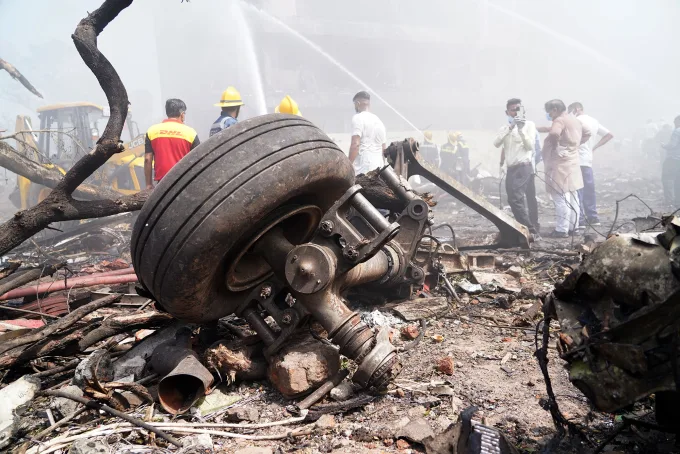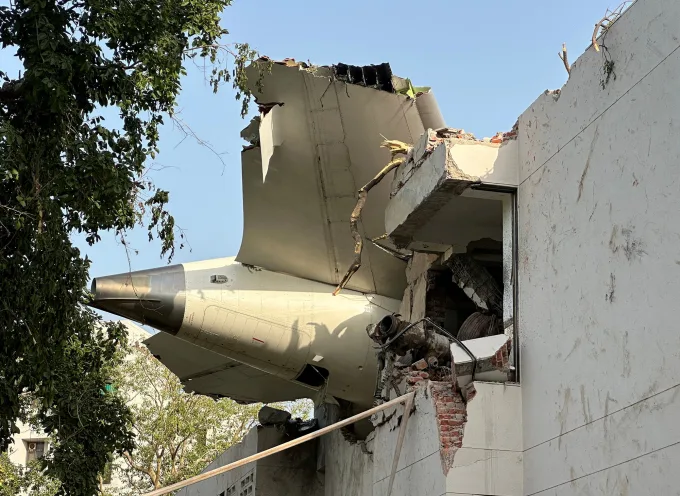Rescue teams on Friday retrieved the black box from the wreckage of an Air India flight that crashed into a residential district in Ahmedabad, India, killing at least 265 people both on board and on the ground.
The Boeing 787-8 Dreamliner was headed to London when it issued a distress signal shortly after takeoff on Thursday. The aircraft had only climbed around 100 meters before it plunged into the densely populated area around noon.
Amazingly, one passenger survived the catastrophe. The aircraft’s tail was left embedded in the second floor of a hostel housing hospital staff.

READ ALSO: Oshiomhole breaks silence on Lagos airport incident
“Initially, I too thought that I was about to die, but then I opened my eyes and realised that I was still alive,” survivor Vishwash Kumar Ramesh, a British national, told DD News from his hospital bed.
Eyewitnesses said the plane’s nose and front landing gear smashed into a cafeteria filled with students.
Deputy Police Commissioner Kanan Desai confirmed the death count at 265, with indications that at least 24 of those fatalities were ground casualties. The final toll could rise as the recovery of body parts continues.

“The official number of deceased will be declared only after DNA testing is completed,” Home Minister Amit Shah said Thursday. Authorities will collect DNA samples from relatives, including those residing overseas.
The airline confirmed the presence of 169 Indian nationals, 53 British citizens, seven Portuguese, and one Canadian among the passengers, in addition to 12 crew members.
Prime Minister Narendra Modi visited the crash site and later met with survivor Ramesh at the hospital.Ramesh, who sustained burns and injuries, recounted: “Everything happened in front of me, and even I couldn’t believe how I managed to come out alive from that.”
“Within a minute after takeoff, suddenly… it felt like something got stuck… I realised something had happened, and then suddenly the plane’s green and white lights turned on.”
According to Aviation Minister Ram Mohan Naidu Kinjarapu, the recovered flight data recorder will play a crucial role in understanding what went wrong.
At a nearby emergency response center, grieving relatives provided DNA samples to assist with the identification process.
Ashfaque Nanabawa, 40, said he was searching for his cousin Akeel, who had been traveling with his wife and young daughter. Their last conversation took place as they boarded.
“He called us and he said: ‘I am in the plane and I have boarded safely and everything was okay’. That was his last call.”Another distraught woman, unable to give her name, said her daughter’s husband had perished.
“My daughter doesn’t know that he’s no more,” she said. “I can’t break the news to her, can someone else do that please?”Volunteers at the scene described horrific conditions.
“The bodies were totally burnt. It was like coal,” said Bharat Solanki, who rushed over from a nearby gas station.
Ahmedabad, the capital of Gujarat state, is a sprawling urban center of eight million, with its airport flanked by tightly packed housing blocks.
“One half of the plane crashed into the residential building where doctors lived with their families,” said Krishna, a physician who chose not to reveal his full name.
Boeing released a statement confirming its contact with Air India and its willingness to assist with the ongoing investigation. According to an insider, this incident marks the first fatal crash involving a 787 Dreamliner.
Following the crash, India’s aviation regulator instructed Air India to carry out further safety checks on its fleet of 787-8/9 aircraft powered by GEnx engines. While Air India operates 34 Dreamliners, it remains unclear how many use the GEnx model.
Air accident teams from the UK and US are also being deployed to support Indian investigators.I
India has experienced several major air disasters in recent decades, including a 1996 mid-air collision over New Delhi that killed nearly 350 people, and a 2010 crash in Mangalore that left 158 dead.

Experts cautioned that it was premature to pinpoint a cause for Thursday’s tragedy.
“The aircraft is designed to be able to fly on one engine, so the most likely cause of the crash is a double engine failure,” said Jason Knight, senior lecturer in fluid mechanics at the University of Portsmouth.
“The most likely cause of a double engine failure is a bird strike.”
India’s aviation sector has expanded rapidly alongside its economy. The nation, home to 1.4 billion people, now ranks as the world’s fourth-largest air travel market and is expected to become the third-largest within a decade, according to IATA forecasts.

